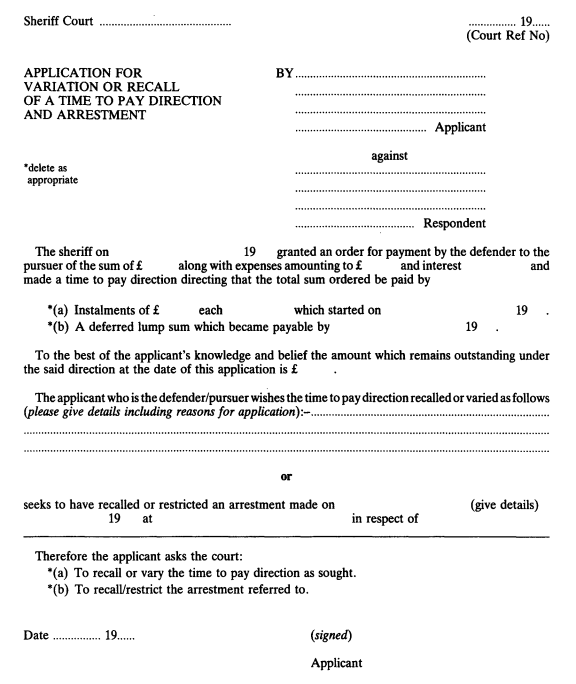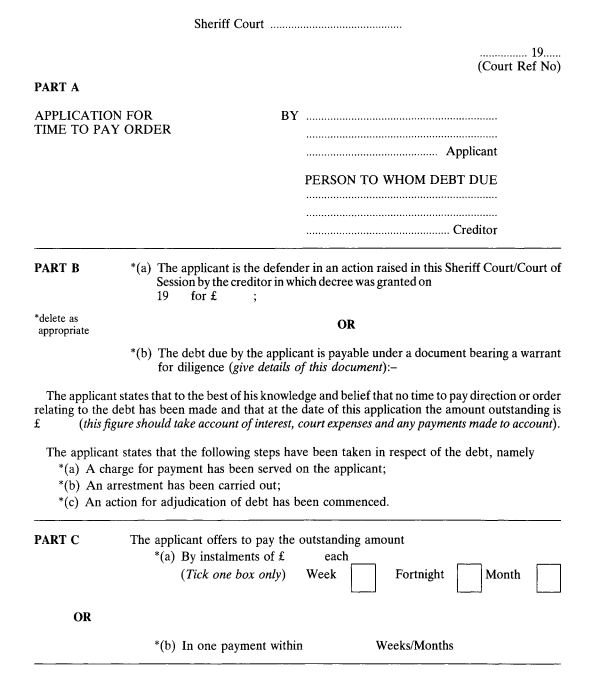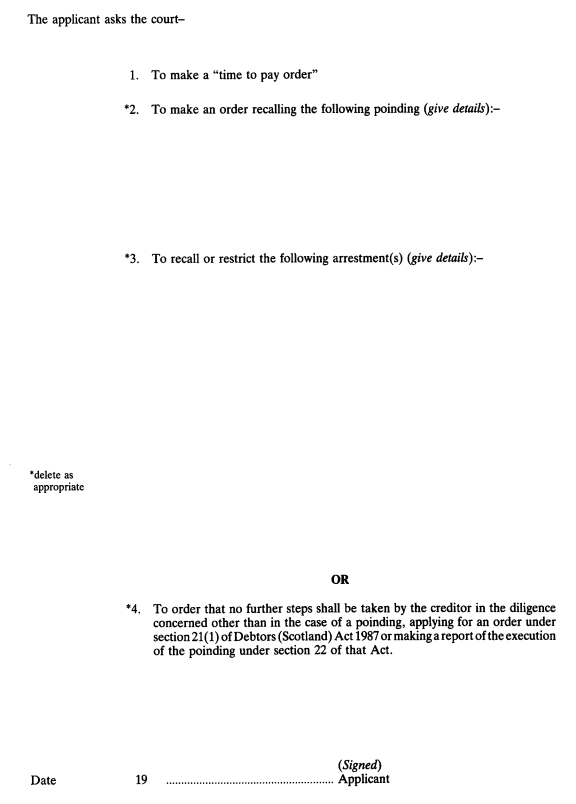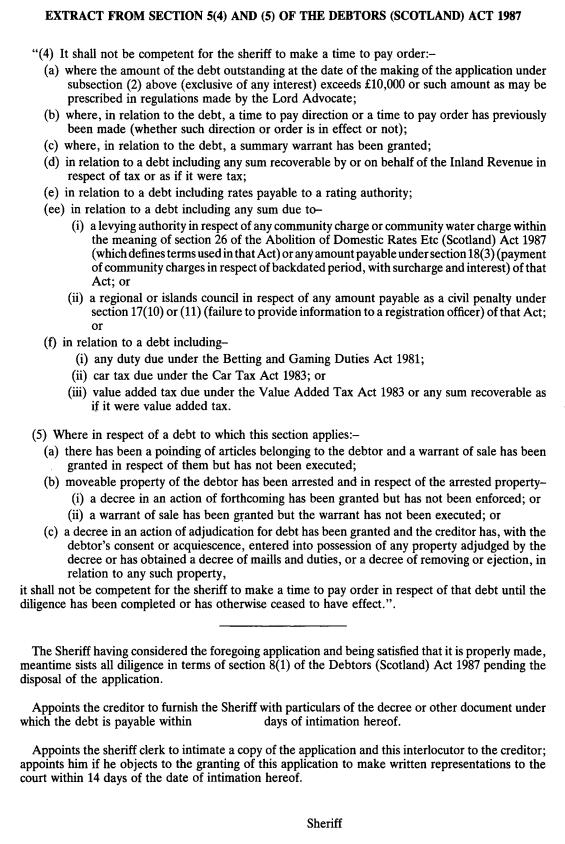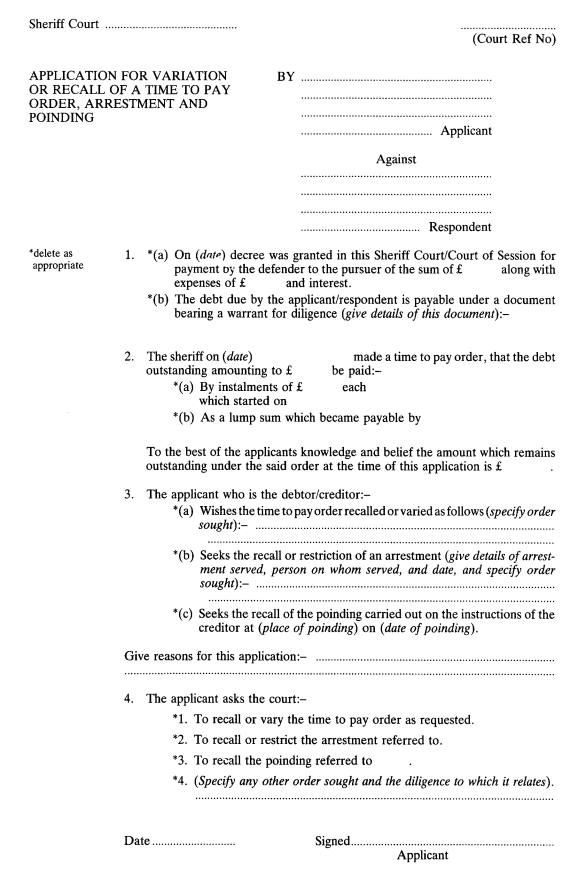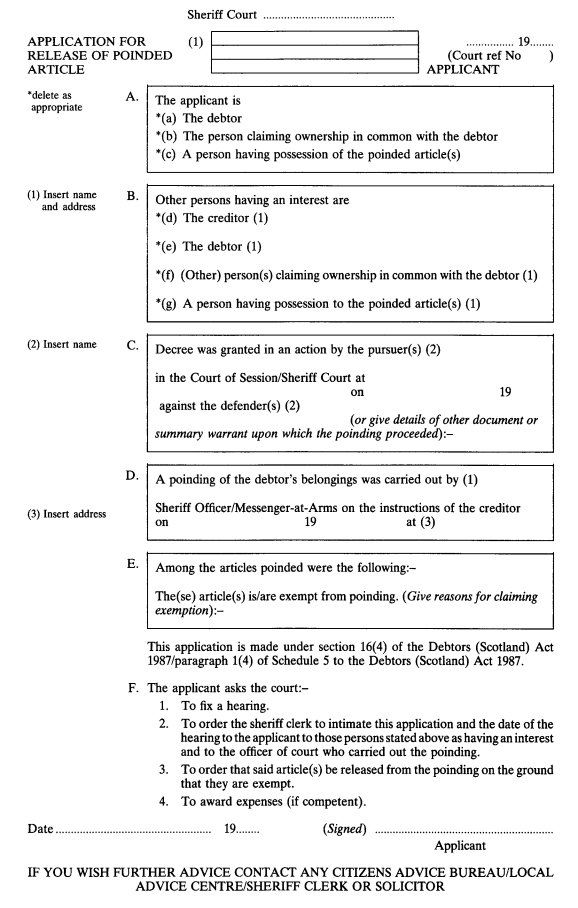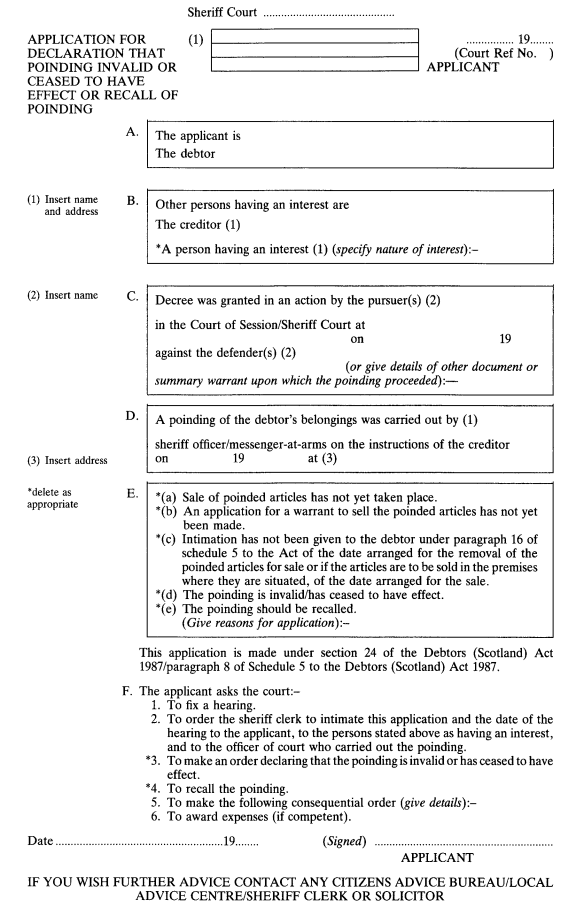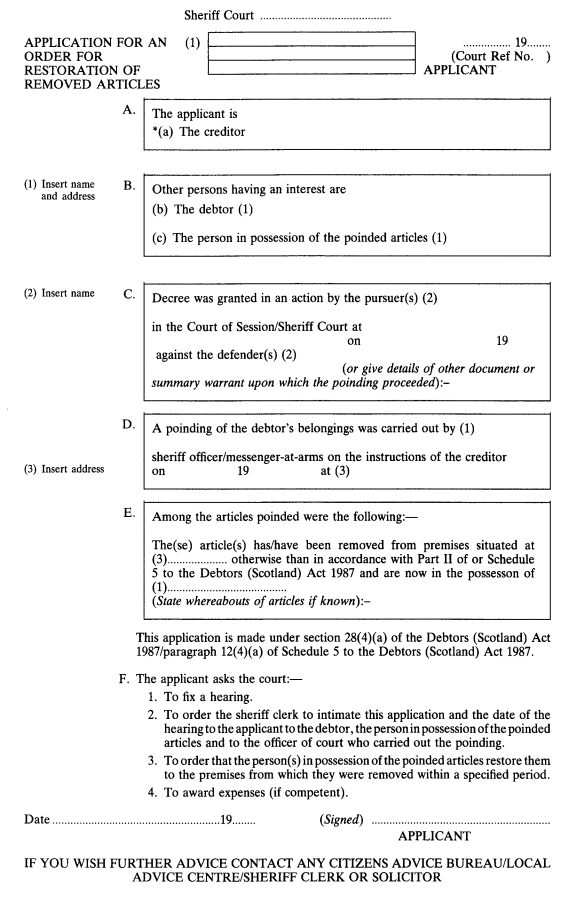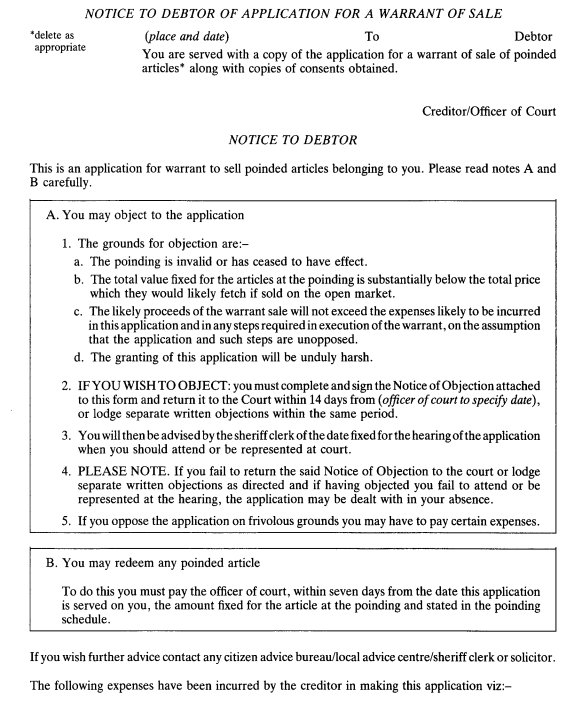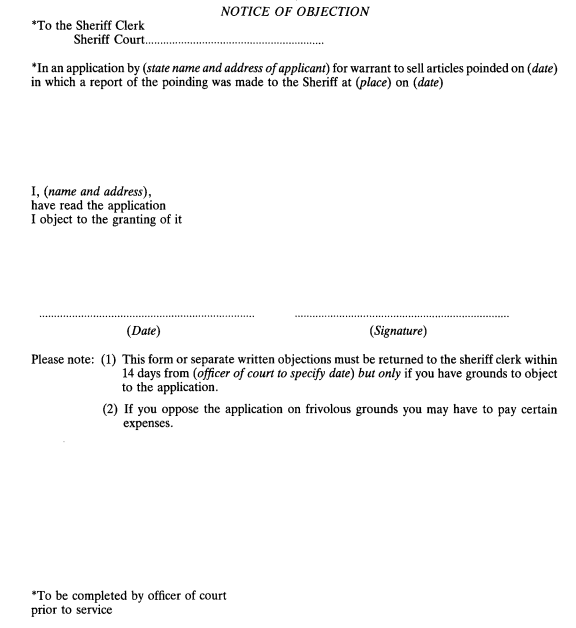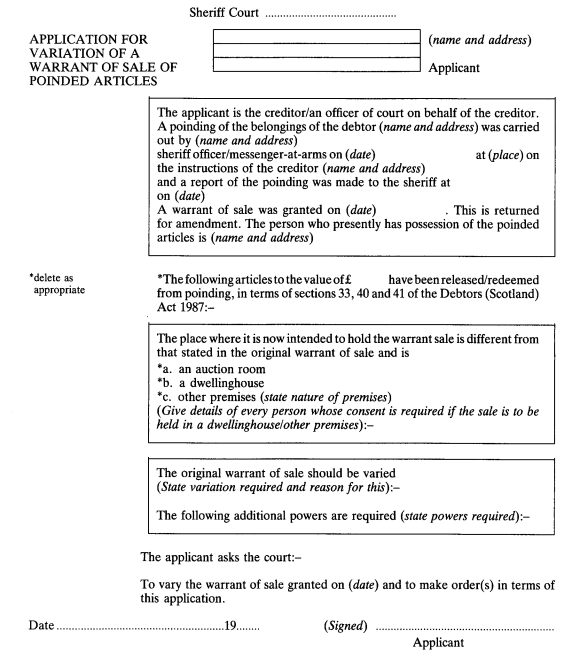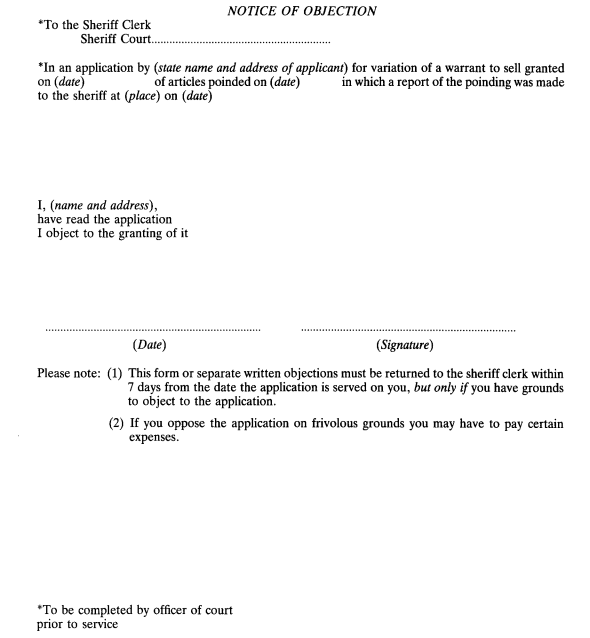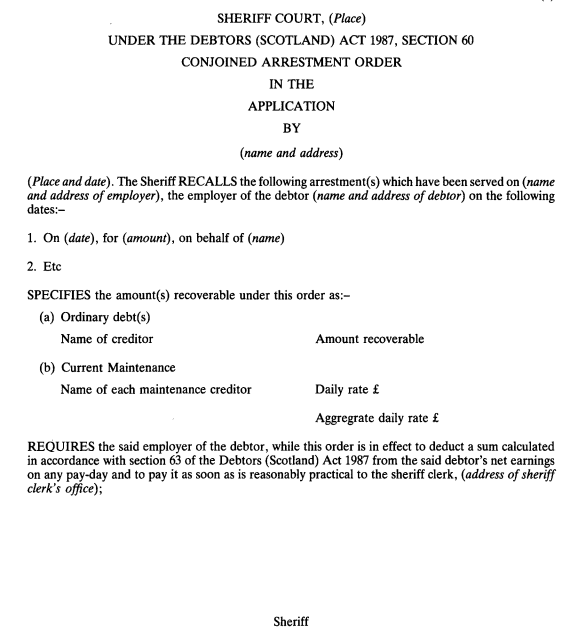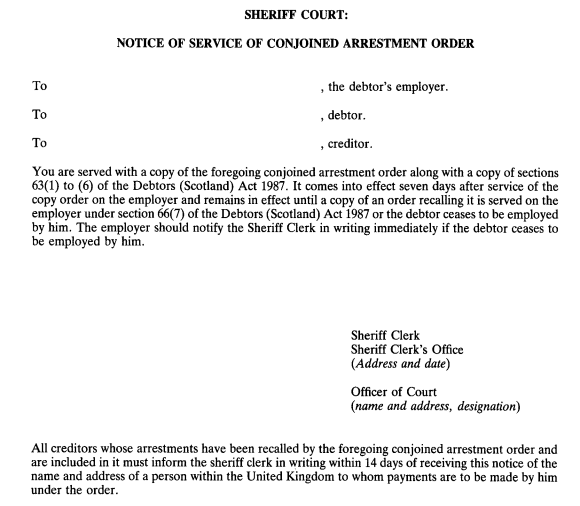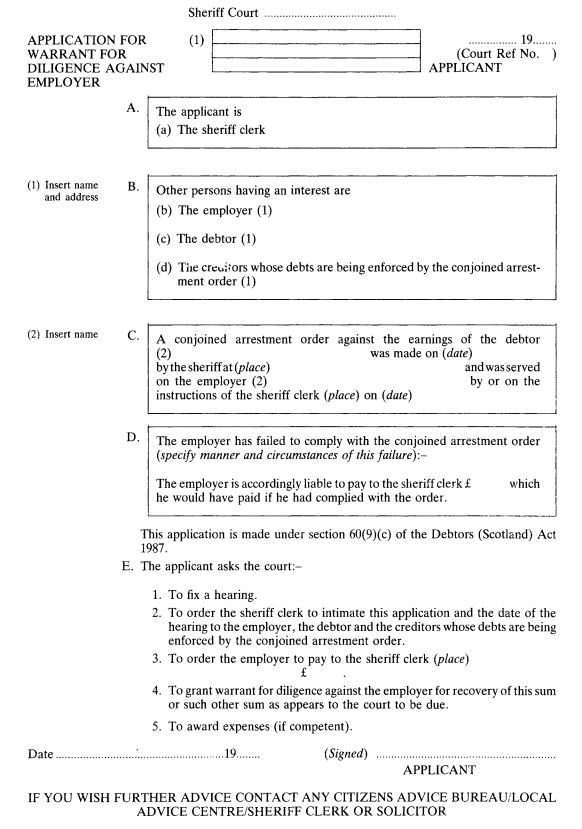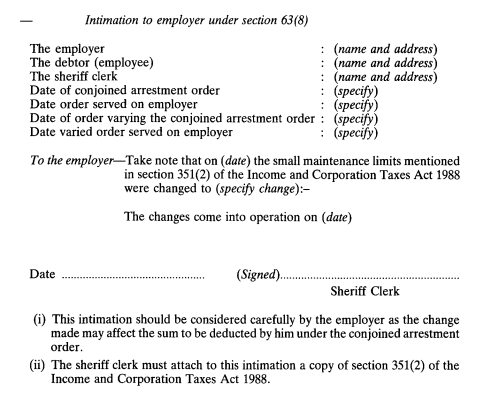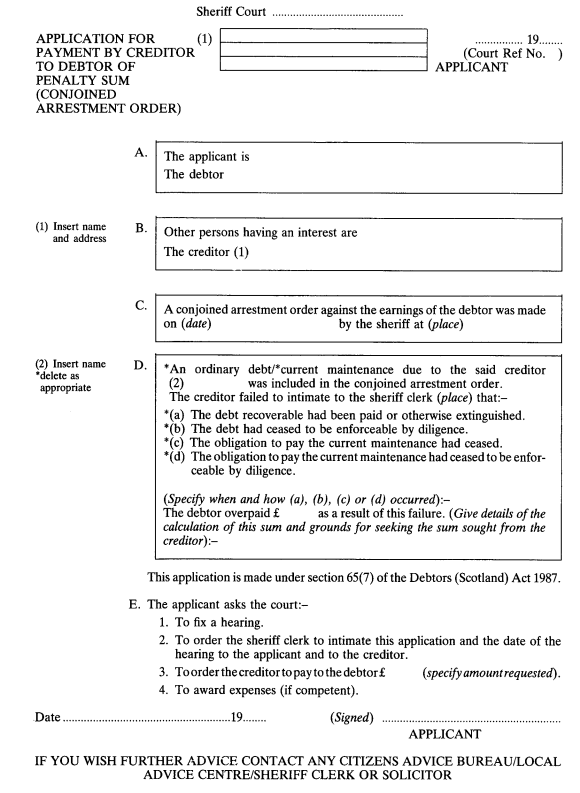- Latest available (Revised)
- Original (As made)
Act of Sederunt (Proceedings in the Sheriff Court under the Debtors (Scotland) Act 1987) 1988
You are here:
- UK Statutory Instruments
- 1988 No. 2013 (S. 192)
- Whole Instrument
- Previous
- Next
More Resources
Status:
This is the original version (as it was originally made). This item of legislation is currently only available in its original format.
Statutory Instruments
1988 No. 2013 (S.192)
SHERIFF COURT, SCOTLAND
Act of Sederunt (Proceedings in the Sheriff Court under the Debtors (Scotland) Act 1987) 1988
Made
16th November 1988
Coming into force
30th November 1988
PART IINTRODUCTORY
Citation and commencement
1.—(1) This Act of Sederunt may be cited as the Act of Sederunt (Proceedings in the Sheriff Court under the Debtors (Scotland) Act 1987) 1988 and shall come into force on 30th November 1988.
(2) This Act of Sederunt shall be inserted in the Books of Sederunt.
Interpretation
2. In this Act of Sederunt—
(a)“the Act” means the Debtors (Scotland) Act 1987; and
(b)a reference to a “form” means the form so numbered in the Schedule to this Act of Sederunt or a form substantially to the same effect with such variation as circumstances may require.
PART IIEXTENSION OF TIME TO PAY DEBTS AND RELATED MATTERS
Notice of interest claimed
3.—(1) A creditor wishing to recover interest under a decree of the sheriff court shall serve on the defender the notice referred to in sections 1(7) and 5(7) of the Act (notice claiming and specifying amount of interest), either by posting it by recorded delivery post or by having it served personally by an officer of court —
(a)in the case of a decree requiring payment by instalments, no later than 14 days before the date on which the last instalment is due to be paid; or
(b)in the case of a decree requiring payment by lump sum within a certain period, no later than 14 days before the last day of such period.
Applications for variation or recall of time to pay directions or for recall or restriction of arrestments
4.—(1) An application under section 3(1) of the Act for an order for variation or recall of a time to pay direction, or where appropriate, for recall or restriction of an arrestment, shall be in form 1.
(2) An application to which paragraph (1) of this rule applies shall be lodged with the sheriff clerk who shall—
(a)fix a date for the hearing of the application (which date shall be not less than 7 days from the date of intimation made under sub-paragraph (c) of this paragraph);
(b)obtain from the sheriff a warrant to intimate the application to the debtor and the creditor;
(c)intimate the application and warrant to the debtor and the creditor; and
(d)complete a certificate of intimation.
Applications for time to pay orders
5.—(1) A party who intends to apply for a time to pay order under section 5 of the Act shall complete and lodge with the sheriff clerk an application in form 2.
(2) An order by the sheriff under section 6(4) of the Act (creditor to furnish particulars of decree or other document) shall require a creditor to furnish the following information—
(a)the date of the decree or other document;
(b)the parties named in it;
(c)where appropriate, the court which granted it;
(d)details of the debt and any interest due; and
(e)any further information, relating to the decree or other document, as the sheriff shall consider necessary to enable him to determine the application.
(3) Service by the sheriff clerk of an application under paragraph (1) of this rule, or of anyinterim order of the sheriff under section 6(3) of the Act, shall be by recorded delivery post and the sheriff clerk shall serve, in like manner and at the same time, a copy of anyinterim order upon the applicant.
(4) Where a creditor fails to comply with an order referred to in sub-paragraph (2) of this rule, any order giving him an opportunity to make representations under section 6(5) of the Act shall be intimated to him by the sheriff clerk.
(5) A creditor may, within 14 days after the date of service of an application under paragraph (1) of this rule, object to the granting of the application by lodging with the sheriff clerk the appropriate portion of form 2 or a letter specifying his objections, including any counter-proposals on it.
(6) If no written objections are received from the creditor within the time specified in paragraph (5) of this rule, the sheriff shall make a time to pay order in accordance with the application.
(7) If written objections are received from the creditor within the time specified in paragraph (5) of this rule, the sheriff clerk shall—
(a)appoint a date for the hearing of the application;
(b)intimate that date to the parties and a copy of the written objections to the applicant; and
(c)advise the applicant that he may accept any counter-proposal prior to the date fixed for the hearing.
(8) Where the debtor accepts counter-proposals made by the creditor in accordance with paragraph (5) of this rule, he shall intimate his acceptance to the sheriff clerk who shall intimate the acceptance to the creditor and advise parties that the hearing of the application will not proceed; and the sheriff shall make a time to pay order in terms of the counter-proposals.
(9) The sheriff clerk shall intimate the decision of the sheriff on the application and any order relating to it to the parties by first class post and at the same time shall advise the creditor of the date when intimation was made to the debtor.
Applications for variation or recall of time to pay orders, poindings or arrestments.
6.—(1) An application under section 10(1) of the Act for an order for variation or recall of a time to pay order or, where appropriate, for recall of a poinding or for recall or restriction of an arrestment shall be in form 3.
(2) An application to which paragraph (1) of this rule applies shall be lodged with the sheriff clerk who shall—
(a)fix a date for the hearing of the application (which date shall be not less than 7 days from the date of intimation made under sub-paragraph (c) of this paragraph);
(b)obtain from the sheriff a warrant to intimate the application to the debtor and the creditor;
(c)intimate the application ad warrant to the debtor and the creditor; and
(d)complete a certificate of intimation.
(3) The sheriff may, where he considers it appropriate, make an order requiring any person in possession of a summons or other writ or who holds an execution of diligence in respect of the debt to deliver it to the court.
Consumer Credit Act 1974
7.—(1) In any proceedings by a creditor or owner to enforce a regulated agreement or any related security within the meaning of the Consumer Credit Act 1974(3), the pursuer shall lodge a copy of any existing or previous time order relating to the debt.
(2) Where a time to pay order is applied for, the applicant shall specify in his application whether a time order, within the meaning of the Consumer Credit Act 1974, relating to the debt has been made.
(3) Where a time order is applied for under the Consumer Credit Act 1974, the applicant shall specify whether a time to pay direction or order relating to the debt has been made.
PART IIIPOINDINGS AND WARRANT SALES
Applications for releasing poinded articles
8.—(1) An application under section 16(4) of, or paragraph 1(4) of Schedule 5 to, the Act for an order that an article be released from a poinding shall be made within 14 days after the date of execution of the poinding and shall be in form 4.
(2) An application to which paragraph (1) of this rule applies shall specify—
(a)the name and address of the person to whom the sheriff clerk will require to intimate the application under paragraph (3)(c) of this rule;
(b)the court which granted the original decree and the date of that decree, or details of the summary warrant or other document, upon which the poinding proceeded;
(c)the date and place of execution of the poinding;
(d)the poinded article sought to be released;
(e)the reasons for seeking release of the poinded article; and
(f)any competent crave for expenses.
(3) On the lodging of such an application the sheriff clerk shall —
(a)fix a date for a hearing;
(b)obtain from the sheriff a warrant for intimation;
(c)intimate the application and warrant to —
(i)the applicant, the creditor and the officer of court who executed the poinding; and
(ii)as appropriate, the debtor, any person whom the applicant informs the sheriff clerk claims to own the poinded article in common with the debtor and any person having possession of the poinded article; and
(d)complete a certificate of intimation.
(4) The officer of court who executed the poinding shall, whether or not he appears to oppose the application, lodge with the court a copy of the poinding schedule before the date fixed for hearing under paragraph (3)(a) of this rule.
(5) The sheriff clerk shall intimate the sheriffs decision on such an application to any person to whom intimation of the application was made but who was not present when the application was determined.
(6) This rule shall apply to the release of an article from arrestment (other than an arrestment of a debtor’s earnings in the hands of his employer), or from a sequestration for rent under a landlord’s right of hypothec, as it applies to the release of an article from poinding.
Applications for extension of hours of poinding
9.—(1) An application by an officer of court under section 17(2) of, or paragraph 2(2) of Schedule 5 to, the Act(4) (extension of hours of poinding) shall be made by endorsing a minute on the extract decree, summary warrant, or other document, upon which the poinding has proceeded.
(2) A minute under paragraph (1) of this rule shall specify—
(a)the extension sought; and
(b)the reason for the extension.
(3) A minute under paragraph (1) of this rule shall not be required to be intimated to any party and the sheriff may grant or refuse it without a hearing.
(4) The terms of the sheriffs decision on an application under this rule shall be endorsed on the extract decree, summary warrant or other document, as the case may be, and may be authenticated by the sheriff clerk.
Access to premises
10.—(1) An application by an officer of court under section 18(2) of, or paragraph 3(2) of Schedule 5 to, the Act to dispense with service of a notice of entry shall be made by endorsing a minute on the extract decree, summary warrant, or other document, upon which the poinding has proceeded.
(2) A minute under paragraph (1) of this rule shall specify the reason why notice might prejudice the execution of the poinding.
(3) A minute under paragraph (1) of this rule shall not be required to be intimated to any party and the sheriff may grant or refuse it without a hearing.
(4) The terms of the sheriffs decision on an application under this rule shall be endorsed on the extract decree, summary warrant or other document, as the case may be, and may be authenticated by the sheriff clerk.
Poinding schedule
11. A poinding schedule under section 20(5) of, or paragraph 5(5) of Schedule 5 to, the Act shall be in form 5.
Applications for security of poinded articles
12.—(1) An application for an order under section 21(1)(a) of, or paragraph 6(1)(a) of Schedule 5 to, the Act for the security of a poinded article shall be in form 6.
(2) The sheriff shall, on the lodging of an application under paragraph (1) of this rule, decide upon the further procedure in respect of it as he may consider appropriate, and may dispose of it without intimation to any party or without a hearing.
(3) Where the sheriff considers it appropriate, a date for a hearing of an application under paragraph (1) of this rule shall be fixed; and the sheriff clerk shall intimate a copy of the application together with a warrant for intimation to the applicant and as appropriate to the debtor, the creditor and the officer of court who executed the poinding, and shall thereafter complete a certificate of intimation.
(4) Where a hearing has been fixed under paragraph (3) of this rule, the officer of court who executed the poinding shall lodge with the court a copy of the poinding schedule before the date of the hearing.
(5) The sheriff clerk shall intimate the sheriff’s decision on such an application to any person to whom intimation of the application was made but who was not present when the application was determined.
Applications for immediate disposal of poinded articles
13.—(1) An application for an order under section 21(1)(b) of, or paragraph 6(1)(b) of Schedule 5 to, the Act for immediate disposal of a poinded article shall be in form 7.
(2) In the case of an application by the debtor under paragraph (1) of this rule, intimation to the creditor or the officer of court as required by section 21(2)(b) of, or paragraph 6(2)(b) of Schedule 5 to, the Act shall be made by the sheriff clerk.
(3) On being satisfied that such an application has been intimated as required by section 21(2) of, or paragraph 6(2) of Schedule 5 to, the Act the sheriff shall determine the further procedure in respect of the application as he considers appropriate.
Receipt of redemption of poinded articles
14. A receipt granted by an officer of court for payment in respect of a poinded article redeemed under section 21(4) of, or paragraph 6(4) of Schedule 5 to, the Act shall be in form 8.
Reports of execution of poindings
15.—(1) A report under section 22(1) of the Act by an officer of court of the execution of a poinding shall be in form 9 and shall state—
(a)the court which granted the original decree and the date of that decree, or details of the document upon which the poinding proceeded, and the date of any charge;
(b)that he did, before executing the poinding—
(i)exhibit to any person present the warrant to poind and the certificate of execution of charge;
(ii)demand payment of the sum recoverable from the debtor, if he was present, or any person present appearing to the officer to be authorised to act for the debtor; and
(iii)make enquiry of any person present as to the ownership of the articles proposed to be poinded, and in particular whether there were any persons who own any article in common with the debtor;
(c)if appropriate, that he informed the debtor of his right to redeem poinded articles, and whether any articles have been redeemed;
(d)if appropriate, that he informed any person present who owns any poinded article in common with the debtor of his right to redeem poinded articles;
(e)if appropriate, that he informed the debtor and any person present who owns any poinded article in common with the debtor, or who is in possession of the poinded article, of his right to apply for an order releasing articles from poinding under section 16(4), 23(1) or 41(3)(b) of the Act;
(f)whether he has carried out any of the actions mentioned in section 20(7) of the Act;
(g)the articles poinded and their respective values;
(h)the sum due by the debtor, including the fees, mileage charges or outlays which have been incurred in serving the charge and executing the poinding, and the amount of each; and
(i)in the case of a further or second poinding, the circumstances justifying the poinding.
(2) A report to which paragraph (1) of this rule applies shall be retained by the sheriff clerk.
(3) An application by an officer of court under section 22(1) of the Act to extend the time for lodging a report shall be made by endorsing a minute to that effect on the extract decree or other document upon which the poinding has proceeded stating the reasons for seeking the extension; and the terms of the sheriffs decision shall be endorsed on the extract decree or other document, as the case may be, and may be authenticated by the sheriff clerk.
Release of poinded articles on ground of undue harshness
16.—(1) An application by a debtor or person in possession of a poinded article for an order under section 23(1) of, or paragraph 7(1) of Schedule 5 to, the Act for release of an article from poinding on the ground of undue harshness shall be made in form 10 within 14 days after the date of the execution of the poinding.
(2) An application to which paragraph (1) of this rule applies shall specify—
(a)the name and address of the persons to whom the sheriff clerk will require to intimate the application under paragraph (3)(c) of this rule;
(b)the court which granted the original decree and the date of that decree, or details of the summary warrant or other document, upon which the poinding proceeded;
(c)the date and place of the execution of the poinding;
(d)the poinded article sought to be released;
(e)the reasons for seeking release of the poinded article; and
(f)any competent crave for expenses.
(3) On the lodging of such an application the sheriff clerk shall —
(a)fix a date for a hearing;
(b)obtain from the sheriff a warrant for intimation;
(c)intimate the application and warrant to the applicant, the creditor, the officer of court who executed the poinding and, as appropriate, the debtor or any person having possession of the poinded article; and
(d)complete a certificate of intimation.
(4) The officer of court who executed the poinding shall, whether or not he appears to oppose the application, lodge with the court a copy of the poinding schedule before the date fixed for hearing under paragraph (3)(a) of this rule.
(5) The sheriff clerk shall intimate the sheriffs decision on such an application to any person to whom intimation of the application was made but who was not present when the application was determined.
(6) Where an application to which paragraph (1) of this rule applies has been granted by the sheriff, an application under section 23(2) of, or paragraph 7(2) of Schedule 5 to, the Act (poinding of other articles belonging to debtor on the same premises) may be made by the creditor or the officer of court—
(a)orally at the time of granting of the application for release of an article; or
(b)endorsing a minute on the order granted.
(7) This rule shall apply to the release of an article from a sequestration for rent under a landlord’s right of hypothec as it applies to the release of an article from poinding.
Invalidity, cessation and recall of poindings
17.—(1) An application by a debtor—
(a)for an order under section 24(1) of, or paragraph 8(1) of Schedule 5 to, the Act (poinding invalid or has ceased to have effect); or
(b)for recall of a poinding under section 24(3) of, or paragraph 8(3) of Schedule 5 to, the Act (undue harshness; aggregate value of articles low; aggregate proceeds of sale would not exceed expenses),
shall be in form 11.
(2) An application to which paragraph (1) of this rule applies shall specify—
(a)the name and address of the creditor, the officer of court who executed the poinding and any other person having an interest;
(b)the court which granted the original decree and the date of that decree, or details of the summary warrant or other document, upon which the poinding proceeded;
(c)the date and place of execution of the poinding;
(d)the reasons for the application and the order sought; and
(e)if appropriate, any competent crave for expenses.
(3) On the lodging of such an application the sheriff clerk shall—
(a)fix a date for a hearing;
(b)obtain from the sheriff a warrant for intimation;
(c)intimate the application and warrant to the applicant, the creditor and any other party having an interest;
(d)intimate the application to the officer of court who executed the poinding with an order that he deliver to the court before the date fixed for the hearing a copy of the poinding schedule; and
(e)complete a certificate of intimation.
(4) The sheriff clerk shall intimate the sheriffs decision on such an application to any person to whom intimation of the application was made but who was not present when the application was determined
Sist of proceedings in poinding of mobile homes
18.—(1) An application by a debtor, or another person, whose only or principal residence is a caravan, houseboat or other moveable structure under section 26(1) of, or paragraph 10(1) of Schedule 5 to, the Act for an order that no further steps be taken in the poinding of such residence shall be in form 12.
(2) An application to which paragraph (1) of this rule applies shall specify—
(a)the name and address of, the debtor or other person whose only or principal residence is the subject of the poinding, the creditor and the officer of court who executed the poinding;
(b)the court which granted the original decree and the date of that decree, or details of the summary warrant or other document, upon which poinding proceeded;
(c)the date and place of execution of the poinding; and
(d)any competent crave for expenses.
(3) On the lodging of such an application the sheriff clerk shall—
(a)fix a date for a hearing;
(b)obtain from the sheriff a warrant for intimation;
(c)intimate the application and warrant to the debtor, the creditor, the officer of court who executed the poinding and any person whose only or principal residence is the subject of the poinding; and
(d)complete a certificate of intimation.
(4) The officer of court who executed the poinding shall, whether or not he appears to oppose the application, lodge with the court a copy of the poinding schedule before the date fixed for the hearing under paragraph (3)(a) of this rule.
(5) The sheriff clerk shall intimate the sheriffs decision on such an application to any person to whom intimation of the application was made but who was not present when the application was determined.
(6) This rule shall apply to the release of an article from a sequestration for rent under a landlord’s right of hypothec as it applies to the release of an article from poinding.
Applications for extension of period of poindings
19.—(1) An application by a creditor or an officer of court under section 27(2) or (3) of, or paragraph 11(2) or (3) of Schedule 5 to, the Act for an extension of the duration of a poinding shall be in form 13.
(2) An application to which paragraph (1) of this rule applies shall specify—
(a)the name and address of the debtor, and where appropriate, the creditor and the officer of court who executed the poinding;
(b)the court which granted the original decree and the date of that decree, or details of the summary warrant or other document, upon which the poinding proceeded;
(c)the date and place of execution of the poinding;
(d)the period of extension sought;
(e)the reasons for making the application; and
(f)where appropriate, any competent crave for expenses.
(3) On the lodging of such an application the sheriff clerk shall—
(a)fix a date for a hearing;
(b)obtain from the sheriff a warrant for intimation;
(c)intimate the application and warrant to the applicant, the debtor and, where appropriate, the officer of court who executed the poinding; and
(d)complete a certificate of intimation.
(4) The officer of court who executed the poinding shall lodge with the court a copy of the poinding schedule before the date fixed for the hearing under paragraph (3)(a) of this rule.
Applications for removal of poinded articles
20.—(1) An application by a debtor or the person in possession of poinded articles under section 28(1)(b) of, or paragraph 12(1)(b) of Schedule 5 to, the Act for authority to remove a poinded article shall be in form 14.
(2) An application to which paragraph (1) of this rule applies shall specify—
(a)the name and address of the creditor, the officer of court who executed the poinding and, as appropriate, the debtor or the person having possession of the poinded article;
(b)the court which granted the original decree and the date of that decree, or details of the summary warrant or other document, upon which the poinding proceeded;
(c)the date and place of execution of the poinding;
(d)the poinded article to be removed and its present location;
(e)the reasons for seeking removal of the poinded article and the order sought; and
(f)any competent crave for expenses.
(3) on the lodging of such an application the sheriff clerk shall—
(a)fix a date for a hearing;
(b)obtain from the sheriff a warrant for intimation;
(c)intimate the application and warrant to the applicant, the creditor, the officer of court who executed the poinding and, as appropriate, the debtor or any person having possession of the poinded article; and
(d)complete a certificate of intimation.
(4) The officer of court who executed the poinding shall, whether or not he appears to oppose the application, lodge with the court a copy of the poinding schedule before the date fixed for the hearing under paragraph (3)(a) of this rule.
(5) The sheriff clerk shall intimate the sheriff’s decision on such an application to any person to whom intimation of the application was made but who was not present when the application was determined.
Unauthorised removal of poinded articles
21.—(1) An application under section 28(4) of, or paragraph 12(4) of Schedule 5 to, the Act for an order for the restoration of a poinded article to the premises from which it was removed shall be in form 15.
(2) An application to which paragraph (1) of this rule applies shall specify—
(a)the name and address of the debtor, the officer of court who executed the poinding and the person having possession of the poinded article;
(b)the court which granted the original decree and the date of that decree, or details of the summary warrant or other document, upon which the poinding proceeded;
(c)the date and place of execution of the poinding;
(d)the article removed;
(e)the present whereabouts of the article, if known;
(f)the order sought; and
(g)any competent crave for expenses.
(3) On the lodging of such an application the sheriff clerk shall—
(a)fix a date for a hearing;
(b)obtain from the sheriff a warrant for intimation;
(c)intimate the application and warrant to the applicant, the officer of court who executed the poinding, the debtor and, where his identity is known, the person in possession of the poinded article; and
(d)complete a certificate of intimation.
(4) The officer of court who executed the poinding shall lodge with the court a copy of the poinding schedule before the date fixed for the hearing under paragraph (3)(a) of this rule.
(5) An application under section 28(5) of, or paragraph 12(5) of Schedule 5 to, the Act shall be made by motion at the hearing fixed under paragraph (3)(a) of this rule.
(6) Where the sheriff makes an order under section 28(4) of, or paragraph 12(4) of Schedule 5 to, the Act for restoration of a poinded article, the sheriff clerk shall serve a certified copy of the order on the person in possession of the article, if known, and shall complete a certificate of service and attach to it the form of application.
(7) Service in accordance with paragraph (6) of this rule shall be by recorded delivery post or by officer of court on payment of his fee by the applicant.
(8) Where an order under section 28(4)(a) of, or paragraph 12(4)(a) of Schedule 5 to, the Act for restoration of a poinded article has not been complied with, an application for a warrant under section 28(4)(b) of, or paragraph 12(4)(b) of Schedule 5 to, the Act may be made by endorsing a minute specifying the warrant craved on the form of application made under paragraph (1) of this rule.
(9) A minute under paragraph (8) of this rule shall be placed before the sheriff who may, where service of the order has been effected in accordance with paragraphs (6) and (7) of this rule, grant the warrant craved without further intimation, service or a hearing.
Poinded articles acquired for value without knowledge of poinding
22.—(1) Where, in an application to which rule 21 applies, the sheriff has made an order for restoration of a poinded article, an application under section 28(5)(b) or (c) of, or paragraph 12(5)(b) or (c) of Schedule 5 to, the Act to recall an order for restoration shall be in form 16.
(2) An application to which paragraph (1) of this rule applies shall specify—
(a)the name and address of the creditor, the debtor, any other person having an interest in the article known to him and the officer of court who executed the poinding;
(b)the court which granted the order for restoration and the date of that order;
(c)where known, the date and place of execution of the poinding;
(d)a description of the article concerned, details of the circumstances of its acquisition for value and without knowledge of the poinding and the applicant’s interest in it;
(e)the order sought; and
(f)any competent crave for expenses.
(3) On the lodging of such an application the sheriff clerk shall—
(a)fix a date for a hearing;
(b)obtain from the sheriff a warrant for intimation;
(c)intimate the application and warrant to the applicant, the creditor, the debtor, the officer of court who executed the poinding and any other person known to the applicant as having an interest in the article or whom the sheriff may name in the warrant; and
(d)complete a certificate of intimation.
(4) The officer of court who executed the poinding shall lodge with the court a copy of the poinding schedule before the date fixed for the hearing under paragraph (3)(a) of this rule.
(5) The sheriff clerk shall intimate the sheriff’s decision on such an application to any person to whom intimation of the application was made but who was not present when the application was determined.
Further poinding in same premises
23.—(1) An application under section 28(6) of, or paragraph 12(6) of Schedule 5 to, the Act for authority to poind another article in premises from which a poinded article has been removed shall be made—
(a)by oral motion in proceedings relating to the poinding; or
(b)in form 17.
(2) Where an application is made in accordance with paragraph (1)(b) of this rule, the application shall specify—
(a)the name and address of the debtor;
(b)the court which granted the original decree and the date of that decree, or details of the summary warrant or other document, upon which the poinding proceeded;
(c)the date and place of execution of the poinding;
(d)the grounds for the application including reasons for alleging that the debtor is at fault; and
(e)any competent crave for expenses.
(3) On the lodging of an application in accordance with paragraph (1)(b) of this rule, the sheriff clerk shall—
(a)fix a date for a hearing;
(b)obtain from the sheriff a warrant for intimation;
(c)intimate the application and warrant to the debtor and the applicant; and
(d)complete a certificate of intimation.
(4) The officer of court who executed the poinding shall lodge with the court a copy of the poinding schedule before the date fixed for the hearing under paragraph (3)(a) of this rule.
(5) The sheriff clerk shall intimate the sheriff’s decision on such an application to any person to whom intimation of the application was made but who was not present when the application was determined.
Damage or destruction of poinded articles
24.—(1) An application under Section 29(2) of, or paragraph 13(2) of Schedule 5 to, the Act for authority to poind another article where a poinded article has been damaged or destroyed or to revalue damaged articles shall be in form 18.
(2) An application to which paragraph (1) of this rule applies shall specify—
(a)the name and address of the debtor;
(b)the court which granted the original decree and the date of that decree, or details of the summary warrant or other document, upon which the poinding proceeded;
(c)the date and place of execution of the poinding;
(d)the poinded article alleged to have been damaged or destroyed;
(e)where appropriate, the reasons for alleging that the debtor is at fault;
(f)where appropriate, the alleged reduction in value;
(g)the order sought; and
(h)any competent crave for expenses.
(3) On the lodging of such an application the sheriff clerk shall—
(a)fix a date for a hearing;
(b)obtain from the sheriff a warrant for intimation;
(c)intimate the application and warrant to the applicant, the debtor, the officer of court who executed the poinding and any other party whom the sheriff may name in the warrant; and
(d)complete a certificate of intimation.
(4) The officer of court who executed the poinding shall lodge with the court a copy of the poinding schedule before the date fixed for the hearing under paragraph (3)(a) of this rule.
(5) The sheriff clerk shall intimate the sheriff’s decision on such an application to any person to whom intimation of the application was made but who was not present when the application was determined.
Applications for consignation by third party
25.—(1) An application under section 29(3) of, or paragraph 13(3) of Schedule 5 to, the Act for an order against a third party to consign a sum of money shall be in form 19.
(2) An application to which paragraph (1) of this rule applies shall specify—
(a)the name and address of the creditor, the debtor, the person in respect of whom an order for consignation is sought and the officer of court who executed the poinding;
(b)the court which granted the original decree and the date of that decree, or details of the summary warrant or other document, upon which the poinding proceeded;
(c)the date and place of execution of the poinding;
(d)the article damaged, destroyed, lost, stolen or sold;
(e)details of the sum for which consignation is sought; and
(f)any competent crave for expenses.
(3) On the lodging of such an application the sheriff clerk shall—
(a)fix a date for a hearing;
(b)obtain from the sheriff a warrant for intimation;
(c)intimate the application and warrant to the applicant, the officer of court who executed the poinding, the person in respect of whom an order for consignation is sought and, as appropriate, the debtor or creditor; and
(d)complete a certificate of intimation.
(4) The officer of court who executed the poinding shall lodge with the court a copy of the poinding schedule before the date fixed for the hearing under paragraph (3)(a) of this rule.
(5) Where an application under paragraph (1) of this rule is granted, the sheriff clerk shall serve a certified copy of the sheriff’s order upon the person concerned and shall complete a certificate of service.
(6) Service under paragraph (5) of this rule shall be by recorded delivery post or by officer of court on payment of his fee by the applicant.
Applications for warrants of sale
26.—(1) An application by a creditor or officer of court under section 30(1) of the Act for a warrant of sale shall be in form 20.
(2) An application to which paragraph (1) of this rule applies shall specify—
(a)the name and address of the applicant, the creditor, any person in possession of the poinded article, the debtor and the auctioneer or officer of court or other person who is to conduct the sale;
(b)the date of the report of execution of poinding to the sheriff;
(c)the name and address of the officer of court who will make the arrangements for the sale in accordance with the warrant;
(d)the intended location of the sale;
(e)the applicant’s proposals for public notice of the sale where it will not be held in an auction room;
(f)the applicant’s proposals for the period within which the sale is intended to take place; and
(g)any release or redemption of a poinded article.
(3) There shall be produced with such an application—
(a)where the sale is to be held in a dwellinghouse, the consent of the occupier, and, if he is not the occupier, of the debtor, to the sale being held in a dwellinghouse; or
(b)where the sale is to be held in premises other than a dwellinghouse or auction room, the consent of the occupier of the premises.
(4) No warrant for service of such an application shall be required.
(5) The notice to be served by the creditor or officer of court under section 30(3) of the Act shall be in form 21.
(6) The creditor or officer of court shall serve on the debtor a copy of any consents referred to in rule 27 with a copy application and notice under this rule.
(7) Service of the copy application and notice under this rule shall be by recorded delivery post or by officer of court; and the applicant shall thereafter complete an execution of service.
(8) A debtor may object to an application to which paragraph (1) of this rule applies by—
(a)completing and returning the appropriate portion of form 21 to; or
(b)lodging written objections with,
the sheriff clerk, within 14 days after the date of making of the application.
(9) Where a debtor lodges an objection under paragraph (8) of this rule, the sheriff clerk shall fix a date for a hearing and intimate it to the parties.
(10) Subject to section 30(4) of the Act, if no objection to an application under paragraph (1) of this rule is lodged, the sheriff may dispose of the application without a hearing.
Location of sales
27.—(1) The forms of consent, required under section 32(1) and (4) of, or paragraph 14(2) and (3) of Schedule 5 to, the Act, to a warrant sale being held in a dwellinghouse or in premises other than a dwellinghouse or an auction room, shall be in form 22.
(2) An application under paragraph 14(4) of Schedule 5 to the Act by the creditor or officer of court for an order that a warrant sale be held in the premises where the poinded article is situated shall be made in Writing and may be determined by the sheriff after such procedure as appears to him appropriate.
Receipts for redemption of poinded articles after application for warrant of sale
28. A receipt granted by an officer of court on the redemption by the debtor of a poinded article under section 33(2) of, or paragraph 15(2) of Schedule 5 to, the Act shall be in form 23.
Intimation and publication of warrants of sale
29.—(1) A copy of every warrant of sale granted under section 30(1), or a variation of a warrant of sale under Section 35(1) or 36(3)(b), of the Act shall be displayed on the walls of the court which granted it until the sale has been concluded.
(2) In the case of a sale of a poinded article which proceeds upon a summary warrant, the particulars to be sent to the sheriff clerk by the officer of court under paragraph 16(2) of Schedule 5 to the Act, shall be—
(a)the name and address of the debtor, the creditor and the officer of court who is making the arrangements for the sale; and
(b)the date, time and place of the sale.
Alteration of arrangements for warrant sales
30.—(1) An application under section 35(1) or 36(3)(b) of the Act for variation of a warrant of sale shall be in form 24.
(2) An application to which paragraph (1) of this rule applies shall specify—
(a)the name and address of the applicant, the creditor, the debtor, any person in possession of the poinded article, and the auctioneer or officer of court who is to conduct the sale;
(b)the date of the original warrant of sale;
(c)details of any steps of diligence taken;
(d)the applicant’s proposals for variation and his reasons for seeking such variation;
(e)any release or redemption of a poinded article;
(f)details of any agreement between creditor and debtor to pay the debt by instalments or otherwise and any breach of it;
(g)details of any cancellation of warrant sale; and
(h)any additional powers sought by the applicant in the event of the application being granted.
(3) There shall be produced with such an application the original warrant of sale.
(4) No warrant for service of such an application shall be required.
(5) The notice to be served by the creditor or officer of court under section 35(5)(a) of the Act(5) shall be in form 25.
(6) The creditor or officer of court shall, after effecting service, complete an execution of service and lodge the principal application and original warrant of sale with the sheriff clerk.
(7) Service of the copy application to which paragraph (1) applies may be by recorded delivery post or by officer of court.
(8) A debtor may object to an application to which paragraph (1) of this rule applies by—
(a)completing and returning the appropriate part of form 25 to; or
(b)lodging written objections with,
the sheriff clerk within 7 days after the date of service of the application.
(9) Where a debtor lodges an objection under paragraph (8), the sheriff clerk shall fix a date for a hearing and intimate it to the parties.
(10) Subject to section 35(6) of the Act, if no objection to an application under paragraph (1) of this rule is lodged, the sheriff may dispose of the application without a hearing.
Reports of warrant sales
31.—(1) A report of sale, under section 39(1) of, or paragraph 20(1) of Schedule 5 to, the Act shall be in form 26.
(2) A report of sale shall specify—
(a)the name and address of the creditor, the debtor and any person, other than the debtor who had possession of the poinded article;
(b)the date of the decree, summary warrant or other document, upon which the sale proceeded, the date of issue of any extract decree and the prior steps of diligence;
(c)details of the warrant of sale and any variation of it;
(d)any intimation, service and notices given by the officer of court in respect of the sale;
(e)when and where the sale took place and the persons who arranged and conducted the sale;
(f)the articles which have been sold and the amount for which they have been sold;
(g)any articles which were not sold and whether their ownership passed to the creditor or reverted to the debtor;
(h)the sum which was due by the debtor and the expenses chargeable against the debtor under Schedule 1 to the Act;
(i)the amount of any surplus paid or to be consigned in court;
(j)any balance of the debt due by the debtor;
(k)any release or redemption of a poinded article whether or not otherwise reported to the court or specified in a warrant of sale or for variation of it; and
(l)any article damaged, destroyed, lost or stolen, any sum consigned by a party in connection with it and any balance of that sum due to the creditor or debtor.
(3) There shall be lodged with the report of sale the extract decree or other document upon which diligence proceeded, the original warrant of sale and any variation of it, any executions or certificates of intimation, service, copies of public notices required by the Act or these rules and vouchers for relevant outlays.
Modification of sale balance and declaration that poinding and sale void
32.—(1) Where the sheriff, after the receipt of the auditor of court’s report, considers—
(a)that a balance due to or by the debtor should be modified; or
(b)that the poinding and sale may be void,
he shall before making an order under section 39(5)(b) or (c) of the Act fix a date for a hearing and the sheriff clerk shall intimate such hearing to the creditor, the officer of court who prepared the report of sale, the debtor and any other person having or having had an interest in or possession of, the poinded article as the sheriff may specify.
(2) Where the sheriff has made an order modifying a sale balance or declaring a poinding and sale to be void, the sheriff clerk shall intimate that order and any consequential order of the sheriff to those persons to whom intimation was made under paragraph (1) of this rule.
Retention of reports of sales
33. A report of sale shall be retained by the sheriff clerk in accordance with section 39(8) of the Act for a period of five years from the date of its being lodged with the court.
Release from poinding of articles belonging to third party
34.—(1) An application under section 40(2) of, or paragraph 21(2) of Schedule 5 to, the Act for release from poinding of an article belonging to a third party shall be in form 27.
(2) An application to which paragraph (1) of this rule applies shall specify—
(a)where known, the name and address of the creditor, the debtor, the officer of court who executed the poinding and any person other than the debtor having possession of the poinded article;
(b)where known, the court which granted the original decree and the date of that decree, or details of the summary warrant or other document, upon which the poinding proceeded;
(c)the date and place of execution of poinding;
(d)if appropriate, where and when the warrant sale is to be held;
(e)the article which is sought to be released; and
(f)any competent crave for expenses.
(3) On the lodging of such an application the sheriff clerk shall—
(a)fix a date for a hearing;
(b)obtain from the sheriff a warrant for intimation;
(c)intimate the application and warrant to the applicant, the creditor, the debtor, the officer of court who executed the poinding and any person having possession of the article; and
(d)complete a certificate of intimation.
(4) The officer of court who executed the poinding shall, whether or not he appears to oppose the application, lodge with the court a copy of the poinding schedule before the date fixed for the hearing under paragraph (3)(a) of this rule.
(5) The sheriff clerk shall intimate the sheriff’s decision on such an application to any person to whom intimation of the application was made but who was not present when the application was determined.
Release from poinding of articles in common ownership
35.—(1) An application under section 41(3), or paragraph 22(3) of Schedule 5 to, the Act for release from poinding of an article in common ownership shall be in form 28.
(2) An application to which paragraph (1) of this rule applies shall specify—
(a)the name and address of the creditor, the debtor, the officer of court who executed the poinding, any person who owns or claims to own the article in common with the debtor and any person other than the debtor having possession of the poinded article;
(b)the court which granted the original decree and the date of that decree, or details of the summary warrant or other document, upon which the poinding proceeded;
(c)the date and place of execution of poinding;
(d)if appropriate, where and when the warrant sale is to be held;
(e)the nature and extent of the applicant’s ownership of the article;
(f)the nature and extent of the debtor’s and any other person’s ownership of the article;
(g)whether an undertaking has been or is made to pay a sum equal to the debtor’s interest in the article;
(h)whether and, if so, why the continued poinding or sale of the article would be unduly harsh to the applicant; and
(i)any competent crave for expenses.
(3) On the lodging of such an application the sheriff clerk shall—
(a)fix a date for a hearing;
(b)obtain from the sheriff a warrant for intimation;
(c)intimate the application and warrant to the applicant, the creditor, the debtor, the officer of court who executed the poinding, any person named in the application who owns or claims to own the article in common with the debtor and any person having possession of the poinded article; and
(d)complete a certificate of intimation.
(4) The officer of court who executed the poinding shall, whether or not he appears to oppose the application, lodge with the court a copy of the poinding schedule before the date fixed for the hearing under paragraph (3)(a) of this rule.
(5) The sheriff clerk shall intimate the sheriff’s decision in such an application to any person to whom intimation of the application was made but who was not present when the application was determined.
Applications for finding of common ownership of poinded article
36.—(1) An application under section 41(7)(b) of, or paragraph 22(6)(b) of Schedule 5 to, the Act for a finding that a poinded article is owned in common shall be in form 29.
(2) An application to which paragraph (1) of this rule applies shall specify—
(a)the name and address of the creditor, the debtor, the officer of court who executed the poinding and any person who owns or claims to own the article in common with the debtor;
(b)where known, the court which granted the original decree and the date of that decree, or details of the summary warrant or other document, upon which the poinding proceeded;
(c)the date and place of execution of poinding;
(d)if appropriate, where and when a warrant sale is to be held;
(e)the article in respect of which the application is made and the nature and extent of the applicant’s ownership of it;
(f)the nature and extent of the debtor’s and any other person’s ownership of the article;
(g)the order sought; and
(h)any competent crave for expenses.
(3) On the lodging of such an application the sheriff clerk shall—
(a)fix a date for a hearing;
(b)obtain from the sheriff a warrant for intimation;
(c)intimate the application and warrant to the applicant, the creditor, the debtor, the officer of court who executed the poinding and any other person whom the sheriff clerk is informed by the applicant also owns or claims to own the article in common with the debtor;
(d)complete a certificate of intimation.
(4) The officer of court who executed the poinding shall, whether or not he appears to oppose the application, lodge with the court a copy of the poinding schedule before the date fixed for the hearing under paragraph (3)(a) of this rule.
(5) The sheriff clerk shall intimate the sheriff’s decision on such an application to any person to whom intimation of the application was made but who was not present when the application was determined.
Conjoining of poindings
37.—(1) An application under section 43(1) of the Act for an order conjoining poindings shall be made by the creditor or officer of court who executed the later poinding endorsing a minute to that effect on the later report of poinding.
(2) A minute to which paragraph (1) of this rule applies shall specify—
(a)that no warrant of sale has been granted in respect of either poinding;
(b)the date of execution of each poinding;
(c)whether any proceedings are subsisting in respect of the later poinding;
(d)whether any proceedings in respect of the later poinding have been disposed of by the sheriff and whether and by whom any leave to appeal has been sought or appeal taken in respect of any such proceedings.
PART IVDILIGENCE AGAINST EARNINGS
Earnings arrestment schedules
38.—(1) An earnings arrestment schedule under section 47(2)(a) of the Act shall be in form 30.
(2) An earnings arrestment schedule shall state—
(a)the name, designation and address of the creditor, the debtor, the employer and any person residing in the United Kingdom to whom payment under the arrestment is to be made;
(b)the decree or other document constituting the debt and when, where and by whom it was granted or issued;
(c)the date on which any charge for payment was served; and
(d)the debt outstanding and the manner of its calculation.
(3) There shall be attached to or reproduced upon the earnings arrestment schedule, and any copy intimated to the debtor, the terms of section 49(1) to (6) of, and Schedule 2 to, the Act.
Intimation of regulations made under section 49(7) of the Act
39.—(1) The form of intimation to an employer under section 49(8) of the Act of regulations under Section 49(7) of the Act varying Tables A, B or C of Schedule 2 to the Act or the percentages specified in section 49(5) or (6)(a)(ii) of the Act shall be in form 31.
(2) The form of intimation required under paragraph (1) of this rule shall specify—
(a)the date of service of the earnings arrestment schedule;
(b)the name and address of the creditor, the debtor and the employer;
(c)that changes in the tables or percentages, as the case may be, have been made by regulations made by the Lord Advocate, the date when they were made and the date of their coming into force.
(3) There shall be attached to or reproduced upon such a form of intimation the full text of the statutory deduction tables as varied by the regulations.
Applications for orders that earnings arrestments invalid etc.
40.—(1) An application under section 50(1) of the Act for declarator that an earnings arrestment is invalid or has ceased to have effect shall be in form 32.
(2) An application to which paragraph (1) of this rule applies shall state—
(a)the name and address of the creditor, the debtor, the officer of court who served the earnings arrestment schedule and the person on whom the schedule was served;
(b)the court which granted the original decree and the date of that decree, or details of the summary warrant or other document, upon which the earnings arrestment proceeded;
(c)the date of service of the earnings arrestment schedule;
(d)the form of order sought;
(e)the reasons for the application; and
(f)any competent crave for expenses.
(3) A copy of the earnings arrestment schedule shall, where practicable, be attached to such an application.
(4) On the lodging of such an application the sheriff clerk shall—
(a)fix a date for a hearing;
(b)obtain from the sheriff a warrant for intimation;
(c)intimate the application and warrant to the applicant, the creditor and, as appropriate, the debtor or the person on whom the earnings arrestment schedule was served and
(d)complete a certificate of intimation.
Determination of disputes as to operation of earnings arrestment
41.—(1) An application under section 50(3) of the Act for determination of any dispute as to the operation of an earnings arrestment shall be in form 33.
(2) An application to which paragraph (1) of this rule applies shall specify—
(a)the name and address of the creditor, the debtor, the officer of court who served the earnings arrestment schedule and the employer;
(b)the court which granted the original decree and the date of that decree, or details of the summary warrant or other document, upon which the earnings arrestment proceeded;
(c)the date of service of the earnings arrestment schedule;
(d)the subject matter of the dispute;
(e)the form of order sought, including any sum sought to be reimbursed or paid;
(f)any claim for interest and the date from which such interest should run; and
(g)any competent crave for expenses.
(3) A copy of the earnings arrestment schedule shall, where practicable, be attached to such an application.
(4) On the lodging of such an application the sheriff clerk shall—
(a)fix a date for a hearing;
(b)obtain from the sheriff a warrant for intimation;
(c)intimate the application and warrant to the applicant and, as appropriate, the creditor, the debtor and the employer; and
(d)complete a certificate of intimation.
(5) The sheriff clerk shall intimate the sheriff’s decision on such an application to any person to whom intimation of the application was made but who was not present when the application was determined.
Current maintenance arrestment schedules
42.—(1) A current maintenance arrestment schedule under section 51(2)(a) of the Act shall be in form 34.
(2) A current maintenance schedule shall state—
(a)the name, designation and address of the creditor, the debtor, the employee and any person residing in the United Kingdom to whom payment under the arrestment is to be made;
(b)the maintenance order constituting the current maintenance, when and by whom it was granted or issued, and, where appropriate, details of its registration or confirmation;
(c)the maintenance payable under the maintenance order by the debtor expressed as a daily rate;
(d)where appropriate, the date of intimation made to the debtor under section 54(1) of the Act(6) and particulars of default; and
(e)whether or not income tax falls to be deducted from the maintenance payable by the debtor.
(3) There shall be attached to or reproduced upon the current maintenance schedule, and any copy intimated to the debtor, the terms of section 53(1) and (2) of the Act.
Intimation of regulations made under section 53(3) of the Act
43.—(1) The form of intimation to an employer under section 53(4) of the Act of regulations under section 53(3) of the Act varying the sum specified in section 53(2)(b) of the Act shall be in form 35.
(2) The form of intimation required under paragraph (1) of these rules shall state—
(a)the date of service of the current maintenance arrestment schedule;
(b)the name and address of the creditor, the debtor and the employer; and
(c)the new sum which is applicable in accordance with regulations made by the Lord Advocate, the date when they were made and the date of their coming into force.
Intimation of changes in small maintenance payments limits
44.—(1) The form of intimation to an employer under section 53(5) of the Act of a change in the small maintenance payments limits shall be in form 36.
(2) The form of intimation required under paragraph (1) of this rule shall specify—
(a)the date of service of the current maintenance arrestment schedule;
(b)the name and address of the creditor, the debtor and the employer; and
(c)that changes have been made to section 351(2) of the Income and Corporation Taxes Act 1988(7), what these changes are and the date of their coming into force.
(3) There shall be attached to or reproduced upon such a form of intimation the full text of section 351(2) of the Income and Corporation Taxes Act 1988.
Intimation to debtors prior to service of current maintenance arrestments
45.—(1) Intimation to a debtor under a maintenance order required by section 54(1)(a) of the Act prior to service of a current maintenance arrestment shall be in form 37.
(2) The form of intimation required under paragraph (1) of this rule shall state—
(a)the name and address of the debtor and the creditor;
(b)where appropriate, details of the making, registration or confirmation of the maintenance order; and
(c)that the debtor has been ordered to pay the sum of maintenance awarded and the consequences of his failure to do so.
(3) A copy of the relevant maintenance order shall be attached to such a form of intimation.
(4) The creditor shall, where the debtor resides in the United Kingdom, intimate to the debtor by posting such a form of intimation in a recorded delivery envelope addressed to him, and where the debtor resides outside the United Kingdom such intimation shall be by any other competent method of service.
(5) The creditor shall prepare and retain an execution of such a form of intimation while the current maintenance arrestment remains in force.
Applications for orders that current maintenance arrestments are invalid etc.
46.—(1) An application under section 55(1) of the Act for declarator that a current maintenance arrestment is invalid or has ceased to have effect shall be in form 38.
(2) An application to which paragraph (1) of this rule applies shall specify—
(a)the name and address of the creditor, the debtor, the officer of court who served the current maintenance arrestment schedule and the person on whom the schedule was served;
(b)the maintenance order and when, where and by whom it was granted or issued and, where appropriate, details of its registration or confirmation;
(c)the date of service of the current maintenance arrestment schedule;
(d)the reasons for seeking the order;
(e)the form of order sought; and
(f)any competent crave for expenses.
(3) A copy of the current maintenance arrestment schedule shall, where practicable, be attached to such an application.
(4) On the lodging of such an application the sheriff clerk shall—
(a)fix a date for a hearing;
(b)obtain from the sheriff a warrant for intimation;
(c)intimate the application and warrant to the applicant, the creditor and, as appropriate, the debtor or the person on whom the current maintenance arrestment schedule was served; and
(d)complete a certificate of intimation.
Recall of current maintenance arrestments
47.—(1) An application under section 55(2) of the Act for recall of a current maintenance arrestment shall be in form 39.
(2) An application to which paragraph (1) of this rule applies shall specify—
(a)the name and address of the creditor, the debtor, the officer of court who served the current maintenance arrestment schedule and the employer;
(b)the maintenance order and when, where and by whom it was granted or issued and, where appropriate, details of its registration or confirmation;
(c)the date of service of the current maintenance arrestment schedule;
(d)such information as the applicant considers appropriate to satisfy the sheriff that he will not default again in paying maintenance;
(e)the order sought; and
(f)any competent crave for expenses.
(3) A copy of the current maintenance arrestment schedule shall, where practicable, be attached to such an application.
(4) On the lodging of such an application the sheriff clerk shall—
(a)fix a date for a hearing;
(b)obtain from the sheriff a warrant for intimation;
(c)intimate the application and warrant to the applicant and the creditor; and
(d)complete a certificate of intimation.
Determination of disputes as to operation of current maintenance arrestments
48.—(1) An application under section 55(5) of the Act for determination of any dispute as to the operation of a current maintenance arrestment shall be in form 40.
(2) An application to which paragraph (1) of this rule applies shall specify—
(a)the name and address of the creditor, the debtor, the officer of court who served the current maintenance arrestment schedule and the employer;
(b)the maintenance order and when, where and by whom it was granted or issued and, where appropriate, details of its registration or confirmation;
(c)the date of service of the current maintenance arrestment schedule;
(d)the subject matter of the dispute;
(e)the form of order sought, including any sum sought to be reimbursed or paid;
(f)any claim for interest and the date from which such interest should run; and
(g)any competent crave for expenses.
(3) A copy of the current maintenance arrestment schedule shall, where practicable, be attached to such an application.
(4) On the lodging of such an application the sheriff clerk shall—
(a)fix a date for a hearing;
(b)obtain from the sheriff a warrant for intimation;
(c)intimate the application and warrant to the applicant and, as appropriate, the creditor, the debtor and the employer; and
(d)complete a certificate of intimation.
Intimation by sheriff clerk where non-Scottish maintenance order ceases to have effect
49. Where a maintenance order pronounced outwith Scotland and registered in a sheriff court for enforcement in Scotland ceases to have effect because the debtor no longer resides in Scotland, the sheriff clerk of that court shall, so far as reasonably practicable, intimate those facts—
(a)where a current maintenance arrestment is in force, to the person upon whom the current maintenance arrestment schedule was served; and
(b)where a conjoined arrestment order is in force, to the sheriff clerk to whom payments require to be made by the employer in terms of such order.
Intimation by creditor under section 57(4) of the Act
50. Intimation by the creditor to an employer required by section 57(4) of the Act shall be in writing.
Applications by debtors for payment by creditors
51.—(1) An application under section 57(6) of the Act by a debtor for an order requiring a creditor to pay an amount not exceeding twice the amount recoverable by the debtor under section 57(5) of the Act shall be in form 41.
(2) An application to which paragraph (1) of this rule applies shall specify—
(a)the name and address of the debtor, the creditor, the officer of court who served the arrestment and the employer;
(b)the court which granted the original decree and the date of that decree, or details of the summary warrant or other document, upon which arrestment proceeded;
(c)the amount of the debt or the sum to be deducted from the debtor’s earnings;
(d)where appropriate, the expenses of diligence;
(e)where appropriate, whether the debt recoverable under the earnings arrestment is paid or otherwise extinguished and, if so, from what date and in what circumstances;
(f)where appropriate, whether the current maintenance arrestment has ceased to have effect and, if so, from what date and in what circumstances;
(g)where appropriate, whether the debt being enforced by the earnings arrestment has ceased to be enforceable by diligence and, if so, from what date and in what circumstances;
(h)the calculation showing the sum alleged to have been received by the creditor in excess of entitlement;
(i)the sum sought from the creditor and the grounds for seeking such sum; and
(j)any competent crave for expenses.
(3) A copy of the relevant arrestment schedule shall, where practicable, be attached to such an application.
(4) On the lodging of such an application the sheriff clerk shall—
(a)fix a date for a hearing;
(b)obtain from the sheriff a warrant for intimation;
(c)intimate the application and warrant to the applicant and to the creditor; and
(d)complete a certificate of intimation.
(5) The sheriff clerk shall intimate the sheriff’s decision in such an application to the creditor if the creditor was not present when the application was determined.
Applications by second creditors for information
52.—(1) An application by a second creditor under section 59(5) of the Act for an order to ordain an employer to give information relating to any other earnings arrestment or current maintenance arrestment to the second creditor shall be in form 42.
(2) An application to which paragraph (1) of this rule applies shall specify—
(a)the name and address of the applicant, the debtor, the employer and the officer of court who served the arrestment schedule in respect of the debt due to the applicant;
(b)the date of service of the applicant’s earnings arrestment or current maintenance arrestment schedule;
(c)that the arrestment did not come into effect by virtue of section 59 of the Act;
(d)the information required by the applicant and which he alleges has not been provided by the employer;
(e)the order sought; and
(f)any competent crave for expenses.
(3) On the lodging of such an application the sheriff clerk shall—
(a)fix a date for a hearing;
(b)obtain from the sheriff a warrant for intimation;
(c)intimate the application and warrant to the applicant and the employer; and
(d)complete a certificate of intimation.
(4) The sheriff clerk shall intimate the sheriff’s decision in such an application to the employer if the employer was not present when the application was determined.
Applications for conjoined arrestment orders
53.—(1) An application under section 60(2) of the Act by a qualified creditor for a conjoined arrestment order shall be in form 43.
(2) An application to which paragraph (1) of this rule applies shall specify—
(a)the name and address of the applicant, the debtor, the employer and any person residing in the United Kingdom to whom payment is to be made in respect of the applicant’s debt;
(b)such information relating to the debt due to the applicant as would require to be specified in an earnings arrestment schedule or, as the case may be, a current maintenance arrestment schedule;
(c)in respect of each earnings arrestment or current maintenance arrestment already in effect against the debtor in the hands of the same employer—
(i)the name and address of the creditor;
(ii)the date and the place of the execution of such arrestments; and
(iii)the debt recoverable specified in the earnings arrestment schedule or, as the case may be, the daily rate of maintenance specified in the current maintenance Schedule; and
(d)the expenses of the application.
(3) On the lodging of such an application the sheriff clerk shall—
(a)intimate the application, together with a form of notice and response in form 44, to the debtor and any other creditor of the debtor already enforcing a debt by an earnings arrestment or current maintenance arrestment in the hands of the same employer; and
(b)complete a certificate of intimation.
(4) Where a creditor or the debtor intends to object to such an application, he shall complete and lodge with the sheriff clerk the form of notice and response in form 44 within 14 days after the date of intimation.
(5) On receipt of such a form of notice and response the sheriff clerk shall fix a date for a hearing and intimate the date to the applicant and any person who received intimation of the application.
(6) Where such a form of notice and response is not timeously lodged with the sheriff clerk, the sheriff may grant the application or may make such other order as he considers appropriate.
Conjoined arrestment orders
54.—(1) A conjoined arrestment order shall be in form 45.
(2) A conjoined arrestment order shall—
(a)specify any earnings arrestment or current maintenance arrestment in effect against the earnings of the debtor in the hands of the same employer;
(b)notify the employer that he must deduct a sum calculated in accordance with section 63 of the Act(8) from the debtor’s net earnings on any pay day and to pay the sum deducted to the sheriff clerk as soon as is reasonably practicable for so long as the order is in effect;
(c)specify, as appropriate, the amount recoverable in respect of the debt or debts and the maintenance, expressed as a daily rate or aggregate of the daily rates;
(d)state the address of the sheriff clerk to whom payments are to be sent and, where appropriate, a court reference number; and
(e)if appropriate, include an award of expenses.
(3) The sheriff clerk shall serve a copy of the conjoined arrestment order (or such final order of the sheriff in an application under rule 53 above) on the applicant, the employer, the debtor and the creditors in any earnings arrestment or current maintenance arrestment recalled by the order.
(4) There shall be attached to or reproduced upon every copy conjoined arrestment order as served on any person the full text of section 63(1) to (6) of the Act.
(5) There shall be enclosed with a conjoined arrestment order served on any person a notice in form 46 which shall require all creditors whose arrestments have been recalled to inform the sheriff clerk, within 14 days of the date of service of the notice, of the name and address of the person within the United Kingdom to whom payments should be made in respect of his debt.
(6) Subject to paragraphs (7) and (8) of this rule, service under this rule shall be by recorded delivery post.
(7) Where such service has been unsuccessful, reservice—
(a)in the case of service on the employer, shall be effected by an officer of court on payment of his fee by the applicant; and
(b)in any other case of service on a person within the United Kingdom, shall be by ordinary first class post.
(8) Service under this rule on a person outside the United Kingdom which cannot be effected by recorded delivery post shall be by any other competent method of service.
Applications by sheriff clerks for warrants for diligence
55.—(1) An application by a sheriff clerk under section 60(9)(c) of the Act for a warrant for diligence against an employer for recovery of sums which are claimed to be due shall be in form 47.
(2) An application to which paragraph (1) of this rule applies shall specify—
(a)the name and address of the sheriff clerk, the employer, the debtor and the creditors under the conjoined arrestment order;
(b)the date of the conjoined arrestment order and details of its service on the employer;
(c)the sum claimed to be due by the employer and details of its calculation; and
(d)the circumstances in which the sum is said to be due and, if appropriate, any reasons given to the sheriff clerk for its not having been paid.
(3) On preparing such an application the sheriff clerk shall—
(a)fix a date for a hearing;
(b)obtain from the sheriff a warrant for intimation;
(c)intimate the application and warrant to the employer, the debtor and the creditors under the conjoined arrestment order; and
(d)complete a certificate of intimation.
Applications by creditors for information under section 62 of the Act
56.—(1) An application by a creditor under section 62(4) of the Act for an order for information which an employer requires to provide in accordance with section 62(2) or (3) of the Act shall be in form 48.
(2) An application to which paragraph (1) of this rule applies shall specify—
(a)the name and address of the applicant, the debtor, the employer and the officer of court who served the arrestment schedule in respect of the debt due to the applicant;
(b)the date of service of the applicant’s earnings arrestment or current maintenance arrestment schedule;
(c)the reason for that arrestment not coming into effect or ceasing to have effect;
(d)the information required by the applicant and which he alleges has not been provided by the employer; and
(e)any competent crave for expenses.
(3) On the lodging of such an application the sheriff clerk shall—
(a)fix a date for a hearing;
(b)obtain from the sheriff a warrant for intimation;
(c)intimate the application and warrant to the applicant and the employer; and
(d)complete a certificate of intimation.
(4) The sheriff clerk shall intimate the sheriff’s decision on such an application to the employer if the employer was not present when the application was determined.
Application for variation of conjoined arrestment orders
57.—(1) An application under section 62(5) of the Act for variation of a conjoined arrestment order by a creditor whose debt is not being enforced under a conjoined arrestment order but would, but for the order, be entitled to enforce the debt by an earnings arrestment or current maintenance order shall be in form 49.
(2) An application to which paragraph (1) of this rule applies shall specify—
(a)the name and address of the applicant, the debtor, the employer and any person residing in the United Kingdom to whom payment is to be made in respect of the applicant’s debt;
(b)the date of the conjoined arrestment order;
(c)such information relating to the debt due to the applicant as would require to be specified in an earnings arrestment schedule or, as the case may be, a current maintenance arrestment schedule; and
(d)the expenses of the application.
(3) On the lodging of such an application the sheriff clerk shall—
(a)intimate the application together with a form of notice and response in form 50 to the debtor and any creditor whose debt is being enforced under the conjoined arrestment order; and
(b)complete a certificate of intimation.
(4) Where a creditor or the debtor wishes to object to such an application, he shall complete and lodge with the sheriff clerk the form of notice and response in form 50 within 14 days after the date of intimation.
(5) On receipt of such a form of notice and response, the sheriff clerk shall fix a date for a hearing and intimate the date to the applicant and to those who received intimation of the application.
(6) Where such a form of notice and response is not timeously lodged with the sheriff clerk, the sheriff may grant the application or may make such other order as he considers appropriate.
(7) Where an application to which paragraph (1) of this rule applies has been granted, there shall be served by the sheriff clerk with the sheriff’s decision—
(a)a copy of the conjoined arrestment order as varied; and
(b)a notice in form 51.
(8) Subject to paragraphs (9) and (10) of this rule, service under this rule and section 62(6) of the Act shall be by recorded delivery post.
(9) Where such service has been unsuccessful, reservice—
(a)in the case of service on the employer, shall be effected by an officer of court on payment of his fee by the applicant; and
(b)in any other case of service on a person within the United Kingdom, shall be by ordinary first class post.
(10) Service under this rule and section 62(6) of the Act on a person outside the United Kingdom which cannot be effected by recorded delivery post shall be by any other competent method of service.
Intimation of changes to calculation of sum payable by employer
58.—(1) Intimation by the sheriff clerk to an employer operating a conjoined arrestment order—
(a)under section 63(7) of the Act, shall be in form 52; or
(b)under section 63(8) of the Act, shall be in form 53.
(2) A form of intimation required under paragraph (1) of this rule shall state—
(a)the date of the conjoined arrestment order and any variation of it and the date of service of it on the employer;
(b)the name and address of the debtor, the employer and the sheriff clerk; and
(c)that changes to—
(i)Tables A, B and C of Schedule 2 to the Act;
(ii)the percentages specified in section 49(5) and (6)(a)(ii) of the Act;
(iii)the sums specified in section 63(4)(b) of the Act; or
(iv)the small maintenance payments limits mentioned in section 65(1A) of the Income and Corporation Taxes Act 1970 have been made and the date when they were made and of their coming into force.
(3) There shall be attached to or reproduced upon form 52 the full text of the appropriate provisions of the Act.
(4) There shall be attached to or reproduced upon form 53 the full text of section 351(2) of the Income and Corporation Taxes Act 1988.
Determination of disputes as to operation of conjoined arrestment orders
59.—(1) An application under Section 65(1) of the Act for determination of any dispute as to the operation of a conjoined arrestment order shall be in form 54.
(2) An application to which paragraph (1) of this rule applies shall specify—
(a)the name and address of the applicant, the debtor, the creditors whose debts are being enforced by the conjoined arrestment order, the employer and the sheriff clerk;
(b)the date of the conjoined arrestment order and the court which made the order;
(c)the subject matter of the dispute;
(d)the order sought, including details of any sum for which reimbursement or repayment is sought;
(e)any claim for interest and the date from which such interest shall run; and
(f)any competent crave for expenses.
(3) On the lodging of such an application the sheriff clerk shall—
(a)fix a date for a hearing;
(b)obtain from the sheriff a warrant for intimation;
(c)intimate the application and warrant to the applicant and, as appropriate, the debtor, the creditors whose debts are being enforced by the conjoined arrestment order and the employer; and
(d)complete the certificate of intimation.
(4) The sheriff clerk shall intimate the sheriff’s decision on such an application to any person to whom intimation of the application was made but who was not present when the application was determined.
Applications for payment by creditors to debtors
60.—(1) An application under section 65(7) of the Act for an order requiring the creditor to pay to the debtor a sum not exceeding twice the sum recoverable by the sheriff clerk in accordance with section 65(6) of the Act shall be in form 55.
(2) An application in which paragraph (1) of this rule applies shall specify—
(a)the name and address of the debtor and creditor;
(b)the date of the conjoined arrestment order and the court which made the order;
(c)whether, in the case of an ordinary debt, the debt has been paid, otherwise extinguished or has ceased to be enforceable by diligence and also why and from what date;
(d)whether, in the case of current maintenance, the obligation to pay maintenance has ceased or has ceased to be enforceable by diligence and if so why and from what date;
(e)the calculation showing the sum alleged to have been received by the creditor in excess of entitlement;
(f)the sum sought from the creditor;
(g)the applicant’s grounds for seeking such sum;
(h)any competent crave for expenses.
(3) On the lodging of such an application the sheriff clerk shall—
(a)fix a date for a hearing;
(b)obtain from the sheriff a warrant for intimation;
(c)intimate the application and warrant to the applicant and the creditor; and
(d)complete a certificate of intimation.
(4) The sheriff clerk shall intimate the sheriff’s decision on such an application to the creditor if the creditor was not present when the application was determined.
Recall of conjoined arrestment orders under section 66(1)(a) of the Act
61.—(1) An application under section 66(1)(a) of the Act by a debtor, creditor, employer, sheriff clerk or interim, or permanent, trustee in the debtor’s sequestration for recall of a conjoined arrestment order shall be in form 56.
(2) An application to which paragraph (1) of this rule applies shall specify—
(a)the name and address of the debtor, the creditors whose debts are being enforced under the conjoined arrestment order, the person on whom a copy of the order or an order varying the order was served under section 60(7) or 62(6) of the Act, any trustee in the debtor’s sequestration and the sheriff clerk to whom payment is made under the order;
(b)the date of the conjoined arrestment order and the court which made the order;
(c)if appropriate, that the conjoined arrestment order is invalid and why it is claimed to be invalid;
(d)if appropriate, that all ordinary debts enforced by the order have been paid or otherwise extinguished or have ceased to be enforceable and in each case when and how this occurred;
(e)if appropriate, that all obligations to pay current maintenance enforced by the order have ceased or have ceased to be enforceable by diligence and in either case when and how this occurred;
(f)if appropriate, that the debtor’s estate has been sequestrated and when this occurred;
(g)the order sought and any consequential order; and
(h)any competent crave for expenses.
(3) Subject to paragraph (4) of this rule, on the lodging of such an application the sheriff clerk shall—
(a)fix a date for a hearing;
(b)obtain from the sheriff a warrant for intimation;
(c)intimate the application and warrant to the applicant and, as appropriate, the debtor, the creditors whose debts are being enforced under the order, the person on whom a copy of the order or an order varying the order was served under section 60(7) or 62(6) of the Act and the interim, or permanent, trustee in the debtor’s sequestration; and
(d)complete a certificate of intimation.
(4) Where such an application has been made by all of the creditors whose debts are being enforced by the conjoined arrestment order or where the sheriff clerk has previously received intimation from all of those creditors as to the matters referred to in section 66(1)(a)(ii) of the Act, the sheriff may grant the application without requiring intimation or any hearing of the application.
Recall of conjoined arrestment orders under section 66(1)(b) of the Act
62.—(1) An application under section 66(1)(b) of the Act by all creditors whose debts are being enforced for recall of a conjoined arrestment order shall be in form 57.
(2) An application to which paragraph (1) of this rule applies shall specify—
(a)the names and addresses of the applicants and the debtors; and
(b)the date of the conjoined arrestment order and the court which made the order;
(c)the reasons for the application; and
(d)any consequential order sought.
(3) On the lodging of such an application the sheriff may grant it immediately or may make such other order as he considers appropriate.
Applications for variation of conjoined arrestment orders
63.—(1) An application under section 66(4) of the Act(9) for variation of a conjoined arrestment order shall be in form 58.
(2) An application to which paragraph (1) of this rule applies shall specify—
(a)the name and address of the debtor, the employer, the creditors whose debts are being enforced by the conjoined arrestment order and the sheriff clerk;
(b)the date of the conjoined arrestment order and the court which made the order;
(c)if appropriate, that any ordinary debt being enforced by the order has been paid, otherwise extinguished or has ceased to be enforceable by diligence and in each case when and how this occurred;
(d)if appropriate, that an order or decree varying, superseding or recalling any maintenance order has come into effect and when and by whom the order or decree was granted;
(e)if appropriate, that an obligation to pay maintenance has ceased or has ceased to be enforceable in Scotland and in either case when or how this occurred;
(f)the order sought; and
(g)any competent crave for expenses.
(3) On the lodging of such an application the sheriff clerk shall—
(a)fix a date for a hearing;
(b)obtain from the sheriff a warrant for intimation;
(c)intimate the application and warrant to the applicant and, as appropriate, to the debtor, the creditors whose debts are being enforced by the conjoined arrestment order and the employer; and
(d)complete a certificate of intimation.
Requests by creditors to cease enforcement of debts by conjoined arrestment orders
64.—(1) A request by a creditor to the sheriff under section 66(6) of the Act to vary a conjoined arrestment order, by ordering that a debt being enforced by him under it shall cease to be so enforced, shall be in writing.
(2) The sheriff may grant or refuse such a request or may make such order as he considers appropriate.
Service of sheriff’s decision in applications for recall or variation of conjoined arrestment orders
65.—(1) Subject to the following paragraphs of this rule, the final order of the sheriff in an application to which rule 61, 62, 63 or 64 applies shall be served upon the applicant, the employer, the debtor and the creditors whose debts are being enforced under the conjoined arrestment order by recorded delivery post.
(2) Where such service has been unsuccessful, reservice—
(a)in the case of service on the employer, shall be effected by an officer of court on payment of his fee by the applicant; and
(b)in any other case of service on a person within the United Kingdom, shall be by ordinary first class post.
(3) Where an application for variation of a conjoined arrestment order to which rule 63 above applies has been granted, there shall be served by the sheriff clerk with the final order—
(a)a copy of the conjoined arrestment order as varied; and
(b)a notice in form 59.
(4) Service under this rule on a person outwith the United Kingdom which cannot be effected by recorded delivery post shall be by any other competent method of service.
Service by post of arrestments against earnings
66. On the face of the envelope used for service of an earnings arrestment schedule, a current maintenance arrestment schedule or a conjoined arrestment order there shall be written or printed the following notice—
“ARRESTMENT OF EARNINGS OF AN EMPLOYEE
This letter contains an earnings arrestment schedule/current maintenance arrestment schedule/conjoined arrestment order. If delivery of the letter cannot be made at the address shown it is to be returned immediately to (name and address).”.
Certificates of execution
67. The certificate of execution of an earnings arrestment or a current maintenance arrestment shall be in form 60.
PART VWARRANTS FOR DILIGENCE
Summary warrants
68.—(1) A summary warrant for recovery of—
(a)arrears of rates under section 247 of the Local Government (Scotland) Act 1947(10); or
(b)arrears of community charge under paragraph 7 of Schedule 2 to the Abolition of Domestic Rates Etc. (Scotland) Act 1987(11),
shall be in form 61.
(2) A summary warrant for recovery of arrears of rates under section 250 of the Local Government (Scotland) Act 1947 shall be in form 62.
(3) A summary warrant for recovery of—
(a)any tax in accordance with section 63 of the Taxes Management Act 1970(12) or of earnings-related contributions under that section as read with regulation 28 of the Income Tax (Employments) Regulations 1973(13);
(b)car tax in accordance with paragraph 3(3) of Schedule 1 to the Car Tax Act 1983(14); or
(c)value added tax in accordance with the Value Added Tax Act 1983(15),
shall be in form 63.
Applications by creditors for warrants to enforce acquired rights
69.—(1) An application to the sheriff clerk under section 88(2) of the Act by a person, who has acquired a right by assignation, confirmation as executor or otherwise to a decree, obligation, order or determination referred to in section 88(1) of the Act for a warrant authorising diligence, shall be made by minute endorsed on the extract decree or other document.
(2) The sheriff clerk shall, where he is satisfied that the applicant’s right is established, endorse the warrant sought in such an application on the extract decree or other document.
PART VIMISCELLANEOUS
Representation
70. A party to any proceedings under the Act shall be entitled to be represented by a person other than an advocate or a solicitor if the sheriff is satisfied that such person is a suitable representative and is duly authorised to represent the party.
Powers of sheriff
71. Without prejudice to any other powers competent to him, the sheriff, in the exercise of the powers conferred on him by these rules, shall have the same powers as regards the summoning and examination of witnesses, the production of documents, the administration of oaths and the correcting of interlocutors as those which he has in an ordinary cause to which the Ordinary Cause Rules in Schedule 1 to the Sheriff Courts (Scotland) Act 1907(16) apply.
Appeals
72.—(1) An application for leave to appeal from a decision of the sheriff under the Act shall be made in writing to the sheriff clerk within 7 days of the making of the decision and shall specify the question of law upon which the appeal is to proceed.
(2) The sheriff may consider such an application without hearing parties unless it appears to him to be necessary to hold a hearing on the application in which case the sheriff clerk shall intimate the date, place and time of the hearing to the parties.
(3) Subject to section 103(2) of the Act, an appeal shall—
(a)be made by note of appeal written by the appellant on the written record containing the order appealed against or on a separate sheet lodged with the sheriff clerk;
(b)be as nearly as may be in the following terms—
“The applicant [or respondentor other] appeals to the sheriff principal/Court of Session”;
(c)be signed by the appellant or his representative and bear the date on which it is signed; and
(d)where appeal is made to the Court of Session, bear the name and address of the solicitors in Edinburgh who will be acting for the appellant.
(4) The appellant shall, at the same time as marking his appeal under paragraph (3) of this rule, intimate that he is doing so to the other parties.
(5) The sheriff shall, on an appeal being marked under paragraph (3) of this rule, state in writing the reasons for his original decision.
(6) Where an appeal is marked, the sheriff clerk shall transmit the process within 4 days to the sheriff principal or to the Deputy Principal Clerk of Session, as the case may be.
Intimation
73.—(1) A warrant for intimation referred to in these rules shall be in form 64.
(2) The sheriff may order intimation to persons other than those to whom intimation is required under these rules as he considers appropriate.
Hearings
74. At any hearing (other than the hearing of an appeal) fixed under these rules the cause to be dealt with may be—
(a)determined;
(b)continued for such further procedure as the sheriff considers appropriate; or
(c)if no party appears, dismissed.
Dispensing power of sheriff
75. The sheriff may relieve any party from the consequences of any failure to comply with the provisions of these rules which is shown to be due to mistake, oversight or other cause, not being wilful non-observance of the same, on such terms and conditions as seem just; and in any such case the sheriff may make such order as seems just by way of extension of time, lodging or amendment of papers or otherwise so as to enable the cause to proceed as if such failure had not happened.
Emslie
Lord President, IPD
Edinburgh
16th November 1988
SCHEDULEFORMS
ARRANGEMENT OF FORMSEXTENSION OF TIME TO PAY AND RELATED MATTERS
| Form No. | Title | Rule |
|---|---|---|
| 1 | Application for variation or recall of a time to pay direction and arrestment | 4(1) |
| 2 | Application for time to pay order | 5(1) |
| 3 | Application for variation or recall of a time to pay order, arrestment and poinding | 6(1) |
| POINDINGS AND WARRANT SALES | ||
| 4 | Application for release of poinded article | 8(1) |
| 5 | Poinding schedule | 11 |
| 6 | Application for security of poinded article | 12(1) |
| 7 | Application for immediate disposal of perishable poinded article | 13(1) |
| 8 | Receipt under s.21(5) of, and para 6(5) of Schedule 5 to the Debtors (Scotland) Act 1987 | 14 |
| 9 | Report of poinding | 15(1) |
| 10 | Application for release of poinded article on ground of undue harshness | 16(1) |
| 11 | Application for declarator that poinding invalid or ceased to have effect or for recall of poinding | 17(1) |
| 12 | Application for sist of proceedings in poinding of mobile home | 18(1) |
| 13 | Application for extension of duration of poinding | 19(1) |
| 14 | Application for authority to move poinded article | 20(1) |
| 15 | Application for an order for restoration of removed article | 21(1) |
| 16 | Application for recall of an order for restoration of removed article | 22(1) |
| 17 | Application for authority to execute further poinding | 23(1)(b) |
| 18 | Application for authority to execute further poinding and/or to revalue damaged article | 24(1) |
| 19 | Application for an order for consignation by third party | 25(1) |
| 20 | Application for warrant of sale of poinded article | 26(1) |
| 21 | Note to debtor of application for warrant of sale | 26(5) |
| 22 | Consent under section 32(1) and 32(4) of, and paragraph 14(2) and (3) of Schedule 5 to, the Debtors (Scotland) Act 1987 | 27(1) |
| 23 | Receipt under section 33(3) of, and paragraph 15(3) of the Schedule 5 to, the Debtors (Scotland) Act 1987 | 28 |
| 24 | Application for variation of a warrant of sale of poinded article | 30(1) |
| 25 | Notice to debtor of application for variation of a warrant of sale | 30(5) |
| 26 | Report of sale | 31(1) |
| 27 | Application for release of poinded article belonging to third party | 34(1) |
| 28 | Application for release of poinded article in common ownership | 35(1) |
| 29 | Application for finding of common ownership of poinded article | 36(1) |
| DILIGENCE AGAINST EARNINGS | ||
| 30 | Earnings arrestment schedule | 38(1) |
| 31 | Intimation to employer under section 49(8) of the Debtors (Scotland) Act 1987 | 39(1) |
| 32 | Application for declarator that earnings arrestment invalid or ceased to have effect | 40(1) |
| 33 | Application for determination of dispute in operation of earnings arrestment | 41(1) |
| 34 | Current maintenance arrestment schedule | 42(1) |
| 35 | Intimation to employer under section 53(4) of the Debtors (Scotland) Act 1987 | 43(1) |
| 36 | Intimation to employer under section 53(5) of the Debtors (Scotland) Act 1987 | 44(1) |
| 37 | Intimation to debtor under section 54(1)(a) of the Debtors (Scotland) Act 1987 | 45(1) |
| 38 | Application for declarator that current maintenance arrestment invalid ceased to have effect | 46(1) |
| 39 | Application for recall of a current maintenance arrestment | 47(1) |
| 40 | Application for determination of dispute in operation of current maintenance arrestment | 48(1) |
| 41 | Application for payment by creditor to debtor of penalty sum | 51(1) |
| 42 | Application for order on employer to provide information | 52(1) |
| 43 | Application for conjoined arrestment order | 53(1) |
| 44 | Form of notice of application for a conjoined arrestment order | 53(4) |
| 45 | Conjoined arrestment order | 54(1) |
| 46 | Notice of service of conjoined arrestment order | 54(5) |
| 47 | Application for warrant for diligence against employer | 55(1) |
| 48 | Application for order on employer to provide information | 56(1) |
| 49 | Application for variation of a conjoined arrestment order | 57(1) |
| 50 | Form of notice of application for variation of a conjoined arrestment order | 57(3)(a) |
| 51 | Notice of service of an order varying a conjoined arrestment order in terms of section 62(5) of the Debtors (Scotland) Act 1987 | 57(7)(b) |
| 52 | Intimation to employer in terms of section 63(7) of the Debtors (Scotland) Act 1987 | 58(1)(a) |
| 53 | Intimation to employer in terms of section 63(8) of the Debtors (Scotland) Act 1987 | 58(1)(b) |
| 54 | Application for determination of dispute in operation of conjoined arrestment order | 59(1) |
| 55 | Application for payment by creditor to debtor of penalty sum (conjoined arrestment order) | 60(1) |
| 56 | Application for recall of conjoined arrestment order | 61(1) |
| 57 | Application for recall of conjoined arrestment order by all creditors whose debts are being enforced by it | 62(1) |
| 58 | Application for variation of conjoined arrestment order | 63(1) |
| 59 | Notice of service of an order varying a conjoined arrestment order in terms of section 66 of the Debtors (Scotland) Act 1987 | 65(3)(b) |
| 60 | Certificate of execution of earnings arrestment schedule/current maintenance arrestment schedule | 67 |
| WARRANTS FOR DILIGENCE | ||
| 61 | Summary warrant for recovery of rates or community charge | 68(1) |
| 62 | Summary warrant for recovery of rates | 68(2) |
| 63 | Summary warrant for recovery of taxes etc. | 68(3) |
| MISCELLANEOUS | ||
| 64 | Warrant for intimation | 73(1) |
Rule 22(1)
FORM 16The Debtors (Scotland) Act 1987 Section 28(5)(b)+(c)/Schedule 5 Paragraph 12(5)(b)+(c)
Rule 27(1)
FORM 22The Debtors (Scotland) Act 1987 consent under Section 32(1)/32(4)/Schedule 5 Paragraph 14(2)/14(3)
Rule 28
FORM 23Receipt under the Debtors (Scotland) Act 1987, Section 33(3)/Schedule 5, Paragraph 15(3)
Rule 67
FORM 60Certificate of execution of earnings arrestment schedule/current maintenance arrestment schedule
Explanatory Note
(This note is not part of the Act of Sederunt)
This Act of Sederunt makes provision for procedures in the sheriff court under the Debtors (Scotland) Act 1987 for:—
(a)applications relating to time to pay directions;
(b)applications for time to pay orders and orders relating thereto;
(c)poindings and warrant sales and orders relating thereto; and
(d)earnings arrestments, current maintenance and conjoined arrestment orders and orders relating thereto.
S.I. 1973/334
1907 c. 51; Schedule 1 was amended by S.I. 1983/747
Options/Help
Print Options
PrintThe Whole Instrument
Legislation is available in different versions:
Latest Available (revised):The latest available updated version of the legislation incorporating changes made by subsequent legislation and applied by our editorial team. Changes we have not yet applied to the text, can be found in the ‘Changes to Legislation’ area.
Original (As Enacted or Made): The original version of the legislation as it stood when it was enacted or made. No changes have been applied to the text.
More Resources
Access essential accompanying documents and information for this legislation item from this tab. Dependent on the legislation item being viewed this may include:
- the original print PDF of the as enacted version that was used for the print copy
- lists of changes made by and/or affecting this legislation item
- confers power and blanket amendment details
- all formats of all associated documents
- correction slips
- links to related legislation and further information resources
More Resources
Use this menu to access essential accompanying documents and information for this legislation item. Dependent on the legislation item being viewed this may include:
- the original print PDF of the as made version that was used for the print copy
- correction slips
Click 'View More' or select 'More Resources' tab for additional information including:
- lists of changes made by and/or affecting this legislation item
- confers power and blanket amendment details
- all formats of all associated documents
- links to related legislation and further information resources
